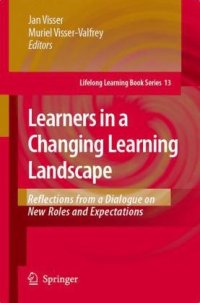
Ebook: Learners in a Changing Learning Landscape: Reflections from a Dialogue on New Roles and Expectations
- Genre: Education
- Tags: Learning & Instruction, Educational Technology, Sociology of Education, Educational Policy and Politics, Higher Education
- Series: Lifelong Learning Book Series 12
- Year: 2008
- Publisher: Springer Netherlands
- Edition: 1
- Language: English
- pdf
This book is about questions. Today's learners face constant change. Adaptive learner expertise is key to their survival on a learning journey that lasts a lifetime. This requires new thinking of all actors in the learning environment. The fundamental process through which this book was created is an extended in-depth dialogue among researchers, lifelong learners, educators, and thinkers.
"Working on this book was a very special kind of experience," says John Bransford (University of Washington), a contributing author to the book and renowned researcher on how people learn. While participating in the dialogue "we were all helped to ‘walk our talk’ and use technology to improve everything we did… I'm convinced that the conversations will not end with this book. Through technology-based dialogue facilitated by the magic touch of the editors’ leadership, I'm sure that all of us—authors and readers of this volume—will continue to learn from one another. This is the way that collaborative science should work."
This book is about questions. Learners are no longer what they used to be. Today's learners find themselves in a learning landscape that is constantly and dramatically changing. The modalities through which people learn; the purposes for which they learn; and the contexts in which learning acquires its meaning, are in permanent flux. Learners must be constantly adaptive as they engage in a learning journey that lasts a lifetime, emphasizing their learner self-efficacy, individually as well as socially. This new reality requires of educators to rethink what it means to teach. Those who develop policies that shape the future of the educational landscape are challenged to take a fresh look at the societal conditions that foster learning. For the research community it means that entirely new questions must be formulated and new ways devised to address them. Because this book is about questions, the fundamental process through which it was created is dialogue. That dialogue took place over a two-year period involving researchers, lifelong learners, educators, and thinkers. The publication of the dialogue in the form of this book addresses the authors peer community: the learners, teachers, researchers and policymakers who will take the dialogue forward and contribute to its further growth. Working on this book was a very special kind of experience, says John Bransford (University of Washington), a contributing author to the book and well known for his involvement in coordinating key research on how people learn. While participating in the dialogue we were all helped to walk our talk and use technology to improve everything we did from preparing for our initial conference presentations to reading and learning from one another s chapters (posted on line) as they were continually improved through extremely helpful editing suggestions. I'm convinced that the conversations will not end with this book. Through technology-based dialogue facilitated by the magic touch of the editors leadership, I'm sure that all of us authors and readers of this volume will continue to learn from one another. This is the way that collaborative science should work.